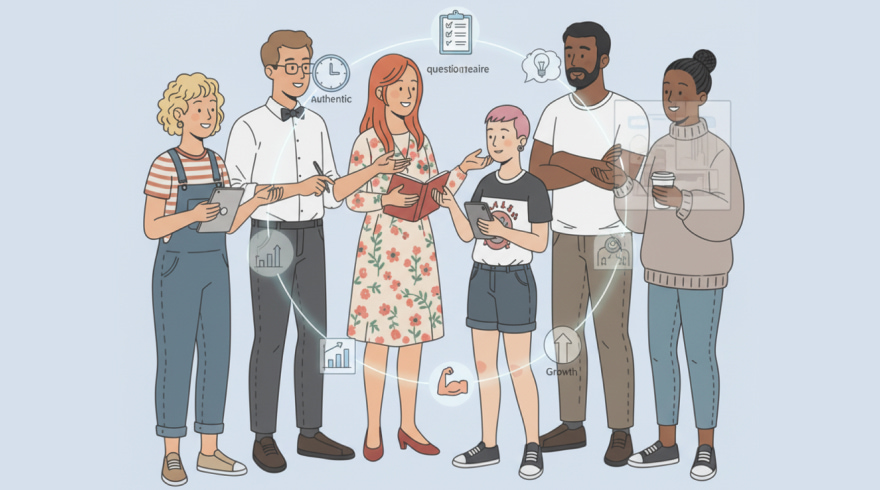Leadership Styles Questionnaire: A Definitive Guide to Insight-Driven Leadership Growth
- 11 November 2025

Why Understanding Leadership Style Matters Today
High-performing organizations rarely arrive there by accident; they cultivate leaders who know their tendencies, strengths, and blind spots. In everyday practice, the term leadership styles questionnaire marks a rigorous path from self-perception to measurable insight. When decision pressure rises, the capacity to recognize one’s default approach, directive, coaching, collaborative, or visionary, can be the difference between alignment and confusion. Clear self-knowledge also empowers a leader to flex behaviors, adjust tone, and select tactics that suit the moment rather than the mood. Teams feel that difference as psychological safety, timely decisions, and consistent accountability.
Beyond the individual benefits, shared language about behavioral preferences helps entire departments create norms that travel across projects. Instead of debating personalities, colleagues can discuss patterns, triggers, and outcomes with candor. That shift unlocks faster onboarding, learner meetings, and smoother cross-functional workflows. It also reduces the costs of miscommunication by encouraging leaders to ask, “What does this situation need?” before acting on habit. Over time, a culture of intentional leadership becomes a strategic asset, not a poster on a wall.
- Clarity: define what “good leadership” looks like in your context.
- Consistency: reinforce behaviors that drive performance and trust.
- Calibration: tailor coaching, feedback, and support to real data.
- Continuity: maintain momentum through change and growth cycles.
What These Assessments Measure and How They’re Built
Modern assessments translate complex behavioral constructs into practical, situation-specific guidance. Across many platforms, a leadership style questionnaire online pairs psychometric rigor with convenient delivery so busy leaders can participate without friction. Items are typically validated against reliability standards, and scoring models combine self-ratings with norm groups to generate nuanced profiles. Quality instruments avoid binary labels by mapping spectrums such as autonomy, structure, empathy, pace, and risk tolerance. The best also weave in situational prompts that surface how style flexes under stress or ambiguity.
To make these concepts easier to scan, the matrix below summarizes common dimensions and what they reveal during daily leadership moments. Use it as a quick reference while interpreting your results and planning experiments with new behaviors.
| Dimension | What It Reveals | When It Matters Most | Typical Development Levers |
|---|---|---|---|
| Decision Pace | Preferred speed from input to action | Crises, time-bound opportunities | Pre-commit criteria, time-box choices |
| Directive vs. Empowering | Balance between instructing and enabling | New teams, low-clarity environments | Role clarity, delegation ladders |
| Relationship Orientation | Investment in rapport and empathy | Conflict, change resistance | Active listening drills, stakeholder mapping |
| Strategic Horizon | Bias toward near-term or long-term outcomes | Portfolio planning, innovation bets | Roadmaps, leading indicators |
| Risk Appetite | Comfort with uncertainty and experimentation | Pivots, pilots, market entry | Guardrails, test-and-learn cycles |
Credible providers document norm samples, scoring logic, and evidence of fairness across roles and demographics. Confidentiality safeguards, clear consent, and non-punitive usage policies are equally important for trust. When those guardrails are in place, leaders engage fully, report richer context in open-ended prompts, and translate insights into targeted practice rather than defensiveness.
Benefits for Managers, Teams, and Organizations
Leaders often describe a step-change in self-awareness after seeing their style mapped against situational demands. In many development programs, a leadership style survey questionnaire becomes the catalyst for honest dialogue about what’s working and what needs to evolve. The resulting conversations move beyond “fixing” people toward aligning behaviors with purpose, strategy, and culture. That reframing reduces friction, clarifies expectations, and stabilizes execution under pressure. It also helps managers discern when to coach, when to decide, and when to invite broad collaboration.
Organizations gain portfolio-level insight by aggregating anonymized patterns across business units and levels. For supervisors stepping into larger span-of-control roles, a managerial style questionnaire provides targeted guidance on delegation, prioritization, and feedback cadence. HR partners can then tailor curricula, peer learning circles, and coaching investments to the real developmental contour of the leadership bench. Over time, this precision reduces training waste, accelerates readiness, and safeguards culture as headcount scales.
- Improved engagement scores through consistent expectations.
- Faster decision cycles with clearer escalation paths.
- Higher retention of top performers who feel recognized and supported.
- Better customer outcomes fueled by aligned cross-functional behavior.
Interpreting Results and Turning Insight Into Action
Insight without application quickly fades, so the real value begins after you read your profile. In most cases, a leadership style questionnaire highlights two or three signature tendencies alongside development opportunities where behavior over- or under-rotates. Start by identifying “critical moments” in your week, hiring decisions, roadmap reviews, customer escalations, where small style shifts could produce outsized impact. Then craft micro-experiments: one meeting where you ask two clarifying questions before proposing a solution, or one sprint where you delegate end-to-end ownership with explicit guardrails.
Document observations immediately after these experiments: what changed in tone, speed, and outcomes. Solicit feedback from a trusted colleague using a simple prompt like “What did you notice me doing differently, and how did it land?” Pair these qualitative notes with leading metrics such as cycle time, error rates, or stakeholder satisfaction. Finally, translate wins into rituals that persist, agenda templates, decision logs, and reflection prompts baked into retrospectives. Repeat quarterly, and your style will become both more adaptable and more deliberate.
- Define 2–3 high-leverage situations to test each month.
- Use pre-commit checklists to reduce reactivity under stress.
- Schedule brief, recurring feedback loops with peers.
- Codify successful behaviors into team norms and playbooks.
Selecting the Right Instrument and Using It Ethically
Not all assessments are created equal, so evaluate providers with the same rigor you’d bring to any critical tool. For distributed teams, an online leadership style questionnaire ensures access across time zones while preserving standardized administration. Seek transparent documentation on validation, reliability coefficients, and representative norm groups. Verify that language is inclusive, items are role-relevant, and reports translate psychometrics into plain business guidance. Avoid instruments that pigeonhole people into immutable labels, as flexibility is the hallmark of effective leadership.
Consider governance as seriously as content, including data security, consent, and purpose limitations. For performance processes, a management style evaluation questionnaire should never stand alone as the basis for promotion or compensation decisions. Instead, combine it with multi-source feedback, outcome metrics, and behavioral evidence gathered over time. Equip facilitators to debrief results constructively, and give participants control over who sees their reports. When ethics are explicit, psychological safety rises and participation rates follow.
- Review technical manuals and independent reviews before rollout.
- Pilot with a small cohort, then refine communications and timing.
- Train managers to use results for development, not for policing.
- Refresh norms and item wording periodically to avoid drift.
Practical Implementation Tips and Rollout Plan
Execution quality determines whether insights translate into behavior change, so design the program with care. In your communications plan, reference a questionnaire leadership style as one element of a broader learning journey that includes coaching, practice, and reflection. Set clear expectations for time commitment, confidentiality, and follow-up actions. Provide participants with a simple interpretation guide, a template for a 90-day development plan, and invitations to peer-learning sessions that reinforce new habits.
Stagger administration dates to avoid overwhelming facilitators and to ensure time for individualized debriefs. Encourage leaders to share one actionable commitment publicly with their teams to create visibility and accountability. Integrate nudges into calendars, project ceremonies, and dashboards so practice opportunities appear where work actually happens. Finally, evaluate impact by correlating behavior changes with business outcomes, and iterate the program based on evidence rather than anecdotes.
- Kickoff: context-setting town hall and clear privacy FAQ.
- Assessment: 20–30 minutes, mobile-friendly access.
- Debrief: 60-minute session with certified coach or trained manager.
- Practice: weekly micro-experiments aligned to role priorities.
- Review: quarterly check-ins with updated goals and metrics.
FAQ: Leadership Style Assessments and Best Practices
How accurate are leadership style assessments?
Accuracy depends on instrument quality, administration integrity, and participant candor. Well-validated tools show strong reliability and predictive validity, particularly when combined with behavioral evidence from the workplace. For self-report formats, accuracy improves when items describe observable actions rather than abstract traits. In curated learning journeys, the inclusion of a discover your leadership style questionnaire can prompt reflection that enhances the quality of subsequent feedback.
Should I use one tool for everyone or different tools for different roles?
Use a common framework for shared language, then layer role-specific modules as needed. Executive roles may need deeper strategic orientation scales, while frontline managers benefit from practical delegation and feedback insights. Consistency at the core prevents fragmentation, and modular add-ons preserve relevance for diverse job families.
Can results change over time?
Yes, especially as context shifts and leaders practice new behaviors. Style preferences are relatively stable, but expression is highly situational. Reassess after significant role transitions, reorganizations, or major market changes to capture meaningful evolution and recalibrate development plans accordingly.
How should I introduce the assessment to reduce skepticism?
Lead with intent and transparency: development, not evaluation. Explain validation, privacy safeguards, and how results will be used. Offer optional Q&A sessions and sample reports so participants know what to expect. Early adopters who share beneficial outcomes can further normalize participation.
What’s the best way to turn insights into lasting habit change?
Convert findings into small, frequent practice loops anchored to real meetings and decisions. Use pre-commit prompts, peer feedback, and progress tracking to keep momentum. Celebrate observable behavior shifts and retire tactics that don’t produce value. Over time, those micro-adjustments compound into a durable leadership operating system.
Latest News
-
![The Complete Guide to Reliable Leadership Evaluation Tools and Their Real-World Value]()
- 10 November, 2025
-
![The Complete Guide to Modern Leadership Capability Assessment]()
- 7 November, 2025
-
![A Practical Guide to Self-Aware Leadership Through Questionnaires]()
- 6 November, 2025



